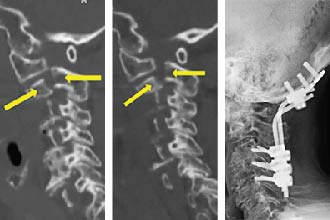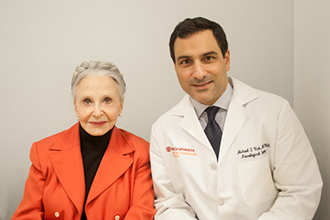
Joyce Carpati knew as soon as it happened that this was no ordinary fall. Of course, she is no ordinary 85-year-old, either: Beauty maven, fashionista, singer, longtime staffer at Cosmopolitan magazine and friend of Helen Gurley Brown, Joyce had never slowed down as the years piled up. She’d never let a fall stop her, either. As she puts it, “as a kid falling off a bike or even as an adult tripping and falling – I’m always running somewhere! – I would always just pick myself up. But this time I couldn’t move.” A spiral staircase in her home, stairs she’d gone up and down countless times, had done her in.
“For some reason this time my foot got stuck in the railing and I just flopped!” she exclaims. “I tried to hold onto the bannister, but I just wasn’t strong enough and I knew I was going down. I couldn’t get up, I couldn’t move, and I said, well, you did something, girl.”
Joyce was lucky that there was someone else home to call for an ambulance, and counts herself even luckier that she was whisked off to NewYork-Presbyterian/Weill Cornell Medical Center, which is a Level 1 Trauma Center equipped to handle emergencies like hers. The initial x-ray showed a serious fracture high on her spine, where the vertebrae are connected to the skull. Joyce had broken her neck.
“I wasn’t in pain, and I knew what was going on,” she remembers, “but I was just lying there thinking well, my life is taking another turn.” That was when she met Dr. Michael Virk, the neurosurgeon and spine specialist who was called in to see her.

Left to right: The fracture from Joyce's fall; the fracture worsening; the occipital cervical fusion
“We were immediately concerned by the fracture morphology,” says Dr. Virk. “It was a Type III fracture extending through the transverse foramen and pars, meaning it affected an important region responsible for head and neck movement. Additionally, the fracture put 2 of the 4 arteries supplying her brain at risk. After careful consideration, we opted for conservative management in a rigid collar to promote healing without surgery."
That was good news, since at 85, and with some osteoporosis weakening her bones, Joyce was not a great candidate for surgery. (Older women are often poor candidates for spine surgery, since the screws that hold vertebrae together can’t get a good grip into their soft, demineralized bones.) “We recommended she wear a neck collar for a few weeks, with close follow-up, while we gave the fracture time to heal on its own.”
Unfortunately, a follow-up x-ray a month after the fall showed that the fracture was worsening. The fracture was more displaced and Joyce had a lot of pain at the back of her head and neck, where the misaligned bones were compressing her C2 nerve root. In addition to her pain, Joyce was at increasing risk for paralysis from the fracture and was facing a lifetime of wearing a cervical collar to protect her fragile neck. Despite Joyce’s age and osteoporosis, Dr. Virk now recommended surgery to repair the break – and Joyce agreed.
“I hadn’t wanted an operation when I first fell,” she says. “It was just too much at my age, I didn’t want it.” But the thought of spending the rest of life debilitated, in pain, and afraid of imminent paralysis, was not going to fly with someone as active as Joyce. Less than 48 hours after that x-ray, Joyce was being prepped for surgery.
Since prolonged time under anesthesia can be especially risky in older patients, Dr. Virk brought in fellow neurosurgeon Dr. Kai-Ming Fu to operate with him, reducing the length of the surgery. Together they performed an occipital cervical fusion, in which the first vertebra is permanently attached to the base of the skull, stabilizing the neck and reducing movement that could have caused paralysis. After just three hours of surgery, Joyce’s neck was repaired. Plastic surgeon Dr. Jason Specter came in to create a durable muscle flap over the hardware and to close up the incision. When Joyce awoke, the pain was gone.
Recovery from surgery is not especially easy for anyone in their 80s, but Joyce was determined to do whatever was needed to reclaim her active life. “It took a few months,” she recalls now. “I couldn’t do anything. I was stuck in a chair, and every time I went in for physical therapy everyone looked at me with such pity. I was so sad — it just wasn’t me. But I wanted to get better, so I decided I had to stop feeling sorry for myself.”

Joyce Carpati with Dr. Michael Virk
Within six months Joyce was back in business. At the advice of her doctors, she now uses a cane to help her balance when she’s outdoors (“I use it because for once in my life I’m listening!” she exclaims.) Indoors, she practices walking without the cane, swinging her arms for natural balance as her rehabilitation team recommended. She goes to the gym every day, and marvels at how much she enjoys her daily life. “This past weekend I got myself a cab and went over to Twelfth Avenue to the Landmark Theater to meet a friend and see a movie – and not a very good one, either,” she reports. “And afterward I took a cab home by myself!” These everyday activities – movies with a friend, time with her son and granddaughter — make Joyce glad she opted for surgery at an age when some others may have given up.
“I’m alive and kicking!” she now says proudly. “People ask if I’m okay – I’m more than okay. I’m lucky to be here.”
Joyce credits the hospital team that cared for her and encouraged her through months of recovery and physical therapy – every one of them warm and helpful, she says. Mostly, though, she is thankful for Dr. Virk for the excellent surgical outcome as well as for the level of personal attention she felt under his care.
“He is very kind, very wonderful, he’s just a fine person,” Joyce says. Coming from someone who has spent her entire life at the height of finery, that’s high praise indeed.